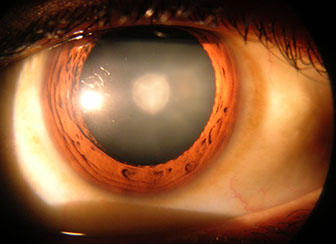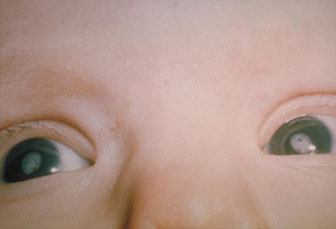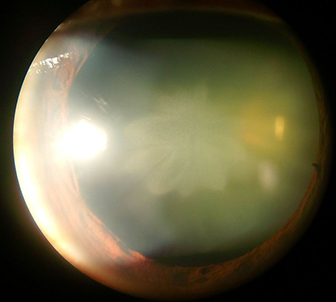Cataract
A cataract is a clouding of the lens in the eye which leads to a decrease in vision. Cataracts often develop slowly and can affect one or both eyes. Symptoms may include faded colors, blurry vision, halos around light, trouble with bright lights, and trouble seeing at night. This may result in trouble driving, reading, or recognizing faces. Poor vision caused by cataracts may also result in an increased risk of falling and depression. Cataracts are the cause of half of blindness and 33% of visual impairmentworldwide.

Magnified view of a cataract seen on examination with a slit lamp
Cataracts are most commonly due to aging but may also occur due to trauma or radiation exposure, be present from birth, or occur following eye surgery for other problems. Risk factors include diabetes, smoking tobacco, prolonged exposure to sunlight, and alcohol. Either clumps of protein or yellow-brown pigment may be deposited in the lens reducing the transmission of light to the retina at the back of the eye. Diagnosis is by an eye examination.

Bilateral cataracts in an infant due to congenital rubella syndrome
Prevention includes wearing sunglasses and not smoking. Early on the symptoms may be improved with glasses. If this does not help, surgery to remove the cloudy lens and replace it with an artificial lens is the only effective treatment. Surgery is needed only if the cataracts are causing problems and generally results in an improved quality of life. Cataract surgery is not readily available in many countries, which is especially true for women, those living in rural areas, and those who do not know how to read.

Post traumatic rosette cataract of a 60-year-old male
About 20 million people are blind due to cataracts. It is the cause of approximately 5% of blindness in the United States and nearly 60% of blindness in parts of Africa and South America. Blindness from cataracts occurs in about 10 to 40 per 100,000 children in the developing world, and 1 to 4 per 100,000 children in the developed world. Cataracts become more common with age. More than half the people in the United States had cataracts by the age of 80.
Signs and symptoms
Signs and symptoms vary depending on the type of cataract, though considerable overlap occurs. People with nuclear sclerotic or brunescent cataracts often notice a reduction of vision. Those with posterior subcapsular cataracts usually complain of glare as their major symptom.
The severity of cataract formation, assuming no other eye disease is present, is judged primarily by a visual acuity test. Other symptoms include frequent changes of glasses and colored halos due to hydration of lens.
Acupressure treatment for cataract:
Cataract means opacity of the lens resulting in loss of vision. It can be congenital or acquired. Congenital cataract: is present at birth.
Acquired cataract: it occurs in old age or due to some injury and as a result of bad effects of radiations, chemicals. Some diseases like diabetes mellitus, cretinism and hypothyroidism also cause cataract.
Treatment: should be started after considering the cause.
Acupressure points: Points 35 Eyes, Du 20, Li 4,11, St 1, GB 14, UB 2, Liv 3, Ex 2,4
Reflex points: eyes, neck, cervical spinal cord, toes, pituitary and kidney.
Leave a Reply